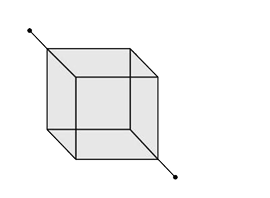Two wire of the same meta have same length, but their cross-sections are in the rati 3:1 . They are joined in series. The resistance of thicker wire is 10Ω . The total resistance of the combination will be
40Ω
403Ω
52Ω
100Ω
The correct Answer is:A
To solve the problem step by step, we will follow these steps:
Step 1: Understand the Given Information
We have two wires made of the same metal, meaning they have the same resistivity (ρ). Both wires have the same length (L), but their cross-sectional areas (A) are in the ratio of 3:1. The thicker wire (let's call it wire A) has a resistance of 10 Ω.
Step 2: Define the Cross-Sectional Areas
Let the cross-sectional area of wire A (the thicker wire) be 3A and the cross-sectional area of wire B (the thinner wire) be A. Thus, we can express the areas as:
- Area of wire A (thicker) = 3A
- Area of wire B (thinner) = A
Step 3: Calculate the Resistances
Using the formula for resistance:
R=ρLA
Since both wires have the same length and resistivity, we can express their resistances as:
- Resistance of wire A (thicker wire):
RA=ρL3A
- Resistance of wire B (thinner wire):
RB=ρLA
Step 4: Relate the Resistances
From the above equations, we can see that:
RB=3RA
This means that the resistance of wire B is three times that of wire A.
Step 5: Substitute Known Values
We know that the resistance of wire A (the thicker wire) is given as 10 Ω:
RA=10Ω
Thus, we can find the resistance of wire B:
RB=3×RA=3×10Ω=30Ω
Step 6: Calculate Total Resistance in Series
When resistors are connected in series, the total resistance (R_total) is the sum of the individual resistances:
Rtotal=RA+RB
Substituting the values we found:
Rtotal=10Ω+30Ω=40Ω
Final Answer
The total resistance of the combination of the two wires is:
Rtotal=40Ω
---
We have two wires made of the same metal, meaning they have the same resistivity (ρ). Both wires have the same length (L), but their cross-sectional areas (A) are in the ratio of 3:1. The thicker wire (let's call it wire A) has a resistance of 10 Ω.
Let the cross-sectional area of wire A (the thicker wire) be 3A and the cross-sectional area of wire B (the thinner wire) be A. Thus, we can express the areas as:
- Area of wire A (thicker) = 3A
- Area of wire B (thinner) = A
Using the formula for resistance:
R=ρLA
Since both wires have the same length and resistivity, we can express their resistances as:
- Resistance of wire A (thicker wire):
RA=ρL3A
- Resistance of wire B (thinner wire):
RB=ρLA
From the above equations, we can see that:
RB=3RA
This means that the resistance of wire B is three times that of wire A.
We know that the resistance of wire A (the thicker wire) is given as 10 Ω:
RA=10Ω
Thus, we can find the resistance of wire B:
RB=3×RA=3×10Ω=30Ω
When resistors are connected in series, the total resistance (R_total) is the sum of the individual resistances:
Rtotal=RA+RB
Substituting the values we found:
Rtotal=10Ω+30Ω=40Ω
The total resistance of the combination of the two wires is:
Rtotal=40Ω
Topper's Solved these Questions
- CURRENT ELECTRICITYBOOK - DC PANDEY ENGLISHCHAPTER - CURRENT ELECTRICITYEXERCISE - B. Assertion and reason
18 Videos
- CURRENT ELECTRICITYBOOK - DC PANDEY ENGLISHCHAPTER - CURRENT ELECTRICITYEXERCISE - Match the columns
4 Videos
- CURRENT ELECTRICITYBOOK - DC PANDEY ENGLISHCHAPTER - CURRENT ELECTRICITYEXERCISE - Check point
70 Videos
- COMMUNICATION SYSTEMBOOK - DC PANDEY ENGLISHCHAPTER - COMMUNICATION SYSTEMEXERCISE - Subjective
11 Videos
- ELECTROMAGNETIC INDUCTIONBOOK - DC PANDEY ENGLISHCHAPTER - ELECTROMAGNETIC INDUCTIONEXERCISE - Medical entrances gallery
25 Videos
Similar Questions
Two metallic wires of the same material B, have the same length out cross-sectional area is in the ratio 1:2. They are connected (i) in series and (ii) in parallel. Compare the drift velocities of electrons in the two wires in both the cases (i) and (ii) .
View SolutionTwo wires of the same materical having equal area of cross-section have L and 2L. Their respective resistances are in the ratio
View SolutionWhen a resistance wire is passed through a die the cross-section area decreases by 1%, the change in resistance of the wire is
View SolutionTwo wires of the same material and same length have radii 1 mm and 2 mm respectively. Compare :
their resistances,
View SolutionA 2 V battery, a 990Ω resistor and a potentiometer of 2 m length, all are connected in series of the resistance of potentiometer wire is 10Ω, then the potential gradient of the potentiometer wire is
View SolutionA 2 V battery, a 990Ω resistor and a potentiometer of 2 m length, all are connected in series of the resistance of potentiometer wire is 10Ω, then the potential gradient of the potentiometer wire is
View SolutionTwo wires of the same dimensions but resistivities ρ1 and ρ2 are connected in series. The equivalent resistivity of the combination is
View SolutionTwelve wires of equal length and same cross-section are connected in the form of a cube. If the resistance of each of the wires is R, and the effective resistance between the two diagonal ends is Re, then the ratio RRe is equal to __.

View SolutionTwo wires of the same dimensions but resistivities p1 and p2 are connected in series. The equivalent resistivity of the combination is
View SolutionTwo wires of the same material and same length have radii 1 mm and 2 mm respectively. Compare :
their specific resistance.
View Solution
